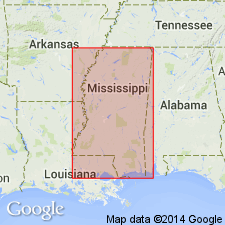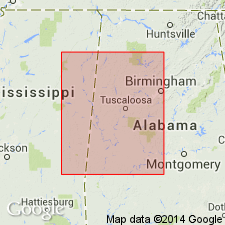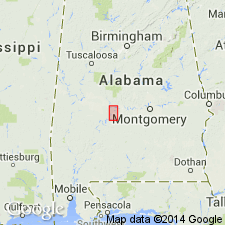
- Usage in publication:
-
- Mooreville tongue
- Modifications:
-
- Named
- Dominant lithology:
-
- Chalk
- Clay
- Marl
- AAPG geologic province:
-
- Black Warrior basin
Summary:
Named Mooreville tongue for Mooreville, Lee Co., MS. Unit is a basal part of the Selma chalk contemporaneous with and grading laterally into lower part of Coffee sand member of Eutaw formation in eastern part of Lee Co. and western part of Itawamba Co. The Mooreville tongue consists of argillaceous chalk and shaly chalky clay or marl. It is 215 ft thick and 20 mi long. The Mooreville overlies the Tombigbee sand member of the Eutaw formation and underlies the Tupelo tongue of the Coffee sand member. Unit is of Late Cretaceous age.
Source: GNU records (USGS DDS-6; Reston GNULEX).

- Usage in publication:
-
- Mooreville Formation*
- Modifications:
-
- Revised
- Age modified
- AAPG geologic province:
-
- Black Warrior basin
Summary:
In MS the Austinian-Tayloran boundary occurs within the Mooreville Formation approximately 21+/-6 m above the Santonian-Campanian boundary. In AL the Santonian-Campanian boundary occurs within the Mooreville, approximately 35 m above the Eutaw-Mooreville contact, and the Austinian-Tayloran boundary occurs within the Mooreville approximately 36.5 m above the Santonian-Campanian boundary. The Arcola Limestone Member of the Mooreville, previously used to designate the Austinian-Tayloran boundary, lies well within the Tayloran Stage. In eastern MS the Santonian-Campanian boundary occurs within the Tombigbee Sand Member of the Eutaw Formation.
Source: GNU records (USGS DDS-6; Reston GNULEX).

- Usage in publication:
-
- Mooreville Chalk
- Modifications:
-
- Biostratigraphic dating
- AAPG geologic province:
-
- Mid-Gulf Coast basin
Summary:
In a composite reference section established in this report in Dallas Co., central AL, along the Alabama and Cahaba Rivers, the Tombigbee Sand Member of the Eutaw Formation and the lower 104 ft of the Mooreville Chalk are of late Santonian age as defined by the presence of DICARINELLA ASYMETRICA. The interval from 104 ft above the base of the Mooreville to 265 ft above the base of the Demopolis Chalk is assigned to the GLOBOTRUNCANITA ELEVATA Interval Zone of early to late Campanian age. The upper 95 ft of the Demopolis Chalk and the lower 50 ft of the Ripley Formation are assigned to the G. TRICARINATA Interval zone (early Maastrichtian). The ages of the stratigraphic units defined herein on the basis of a composite reference section in central AL using planktonic Foraminifera and ostracodes agree well with previous studies using calcareous microfossils. However, the ages of the units as published by King and Skotnicki (1992) and King (1993) are not based on any biostratigraphic or chronostratigraphic data and are suspect.
Source: GNU records (USGS DDS-6; Reston GNULEX).
For more information, please contact Nancy Stamm, Geologic Names Committee Secretary.
Asterisk (*) indicates published by U.S. Geological Survey authors.
"No current usage" (†) implies that a name has been abandoned or has fallen into disuse. Former usage and, if known, replacement name given in parentheses ( ).
Slash (/) indicates name conflicts with nomenclatural guidelines (CSN, 1933; ACSN, 1961, 1970; NACSN, 1983, 2005, 2021). May be explained within brackets ([ ]).

